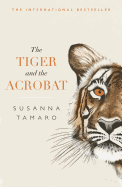
Little Tiger is different. She does not want to claim a kingdom for herself and spend her time hunting big game. "She had no desire to tear or mangle, or display any form of supremacy. The hunger that consumed her was, rather, for knowledge." What makes a tiger a tiger, and what makes a man a man, and what makes a hare a hare? Why does the sun never grow closer, no matter how far we travel towards it? What is the purpose of her life, and how would she know it? This questioning is at the heart of Susanna Tamaro's The Tiger and the Acrobat, translated from the Italian by Nicoleugenia Prezzavento and Vicki Satlow. As her questioning leads her across the wintery forests of Siberia and into the company of Man, Tamaro's simple, almost juvenile language becomes the novel's greatest feature, coloring the innocence and naivety with which Tiger views the world.
The Tiger and the Acrobat is a fable in the truest sense of the word, with human-like animals whose adventures and conversations convey a series of lessons about life to the reader. Though the form can be one-dimensional at times, Tamaro uses it to great effect to explore the power and beauty of the natural world, the place of man in the order of things, and what it means to be true not only to oneself, but to those we love--no matter the cost. Slim but powerful, The Tiger and the Acrobat is rich with reflections on purpose and meditations on what it means to be oneself. --Kerry McHugh, blogger at Entomology of a Bookworm

